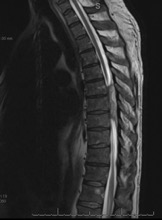Case Presentation: A 56-year-old male with uncontrolled Type II diabetes presented to urgent care with back pain in the absence of urinary tract symptoms. Urine cultures were positive for Methicillin-resistant Staphylococcus aureus (MRSA) and he was diagnosed with pyelonephritis and treated with Bactrim. His back pain persisted and he re-presented to the outside hospital. Finally, on a third presentation, blood cultures were drawn and the patient was admitted to the hospital. Imaging showed bilateral pyelonephritis and the patient was started on vancomycin. He was transferred to our hospital when he developed rapidly progressive lower extremity weakness with complete loss of sensation and motor function from the waist down. Upon admission, the patient was afebrile and non-toxic appearing. Patient interview and outside hospital records revealed the patient had been experiencing back pain for six months prior. Physical exam was remarkable for loss of sensation and strength from the epigastric region down. He had no leukocytosis, and blood and urine cultures were drawn. An MRI pan-spine with contrast confirmed a large epidural abscess with concern for osteomyelitis. Our orthopedic-spine service performed a decompressive laminectomy and spinal fluid cultures turned positive for MRSA. Blood cultures at the outside hospital returned positive for MRSA, as well. A transthoracic echo showed no vegetation. On hospital day four, the patient began to slowly regain purposeful movement in the right lower extremity, however the left remained unchanged. The patient was transferred to a skilled nursing facility on hospital day seven.
Discussion: While Staphylococcus aureus infections and acute urinary tract infections are both independently common syndromes, Staphylococcus aureus bacteriuria (SABU) itself is rare. Most researchers acknowledge primary and secondary causes of SABU. Primary SABU tends to be associated with an ascending infection, dysuria, and is more common in older men who have had recent catheterization or hospitalization. Others describe a more ominous secondary seeding of the bladder from hematogenous spread, implying the original source of infection being outside the urinary tract. In these cases, SABU is a marker for Staphylococcus aureus bacteremia (SAB) and therefore osteomyelitis is a common underlying source, as was the case with this patient. In the absence of urinary tract symptoms, our patient’s back pain could have raised the question of a secondary SABU with osteomyelitis. Instead, a clinician prematurely closed on the diagnosis of primary SABU despite the lack of risk factors. When the patient then presented with refractory symptoms, the clinician remained incorrectly anchored on this diagnosis until the patient eventually developed paraplegia.
Conclusions: In the absence of typical risk factors and symptoms for primary SABU, such as dysuria, supra-pubic pain, recent hospitalization or catheterization and with urine cultures positive for Staphylococcus aureus, the hospitalist should consider secondary SABU. If there is concern for secondary SABU, it is essential to identify the true source of infection by performing a complete infectious work-up for all patients. Lastly, in order to maximize patient care and reduce mortality, it is crucial to be aware of anchoring bias and pre-mature closure.

